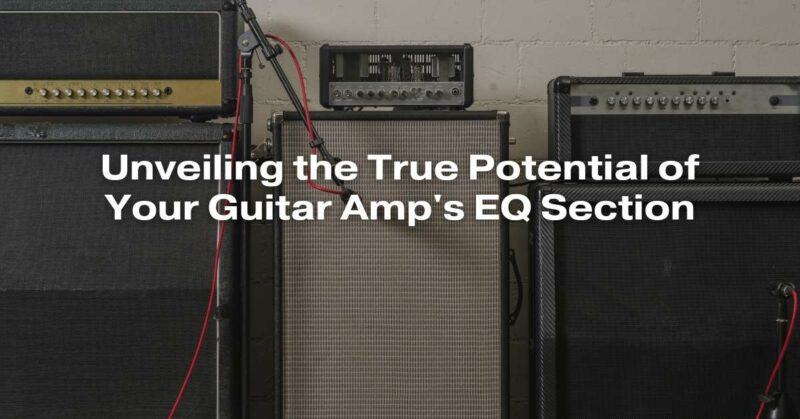The electric guitar is a versatile instrument with a vast array of tonal possibilities. While much of a guitarist’s tone comes from their choice of guitar and playing technique, the amplifier plays a crucial role in shaping the final sound. One of the most powerful tools at your disposal within your guitar amplifier is the EQ section. Understanding and mastering the EQ controls on your amp can make a significant difference in your tone, allowing you to unlock its true potential.
The Basics of EQ
EQ, short for equalization, is the process of adjusting the balance of different frequency ranges in an audio signal. In the context of your guitar amp, this means controlling the bass, midrange, and treble frequencies to shape the overall sound of your guitar.
Typically, a guitar amp’s EQ section consists of three main controls:
- Bass: This control adjusts the low frequencies, affecting the depth and warmth of your tone. Turning it up increases bass frequencies, providing a fuller sound, while reducing it can make your tone sound tighter and more focused.
- Midrange: The midrange control adjusts the frequencies in the middle of the audio spectrum. This control is crucial for shaping your guitar’s character. Boosting the midrange can make your guitar sound more present and cutting, while cutting the midrange can result in a scooped, more modern sound.
- Treble: The treble control governs the high frequencies in your signal. Cranking it up can add brightness and sparkle to your tone, while reducing it can make your sound smoother and less harsh.
Finding Your Sound
The first step in unveiling your amp’s EQ potential is to experiment. Spend time getting to know how each control affects your tone by making small adjustments while playing. Listen carefully to how each change affects the overall sound and try to identify the qualities you like or dislike.
Remember that the “ideal” EQ settings can vary widely based on your playing style, the type of music you’re playing, and the specific amp and guitar you’re using. There’s no one-size-fits-all answer, so don’t be afraid to experiment until you find the sound that best suits your needs.
Balancing Act
While each control has its specific frequency range, they are not isolated from one another. Adjusting one control can impact the others. This interplay is essential for crafting a balanced and harmonically rich tone.
For instance, if you crank the bass control, you may find that the overall sound becomes muddy. In such a case, you may need to reduce the bass and increase the treble or midrange to maintain clarity. Conversely, boosting the treble might make your tone sound too harsh, and lowering the midrange may result in a thin, weak sound. Experimenting with these interactions is key to achieving a well-balanced tone.
EQ Tips and Techniques
To help you unveil the true potential of your guitar amp’s EQ section, consider these tips and techniques:
1. Start with a Flat EQ
Before making any adjustments, set all EQ controls to their midpoints or “flat” positions. This provides a neutral starting point from which you can build your sound. It’s much easier to add or subtract frequencies from a neutral starting point than to start with extreme settings and try to dial them back.
2. Listen to Your Guitar
Your guitar itself has a unique tonal character. Different pickups, woods, and body shapes produce different sounds. Listen to your guitar’s natural voice and use the amp’s EQ to enhance its strengths and compensate for any weaknesses.
3. Consider Your Playing Environment
The acoustics of the room you’re playing in can have a significant impact on your tone. If you’re in a small, reflective space, you may need to adjust your amp’s EQ differently than you would in a larger, more acoustically treated room. Be prepared to make on-the-fly adjustments based on the environment.
4. Use Your Ears, Not Your Eyes
It’s easy to get caught up in the visual aspect of adjusting EQ controls, but remember that your ears are the ultimate judge. Close your eyes, play your guitar, and use your ears to guide your adjustments. Trust your instincts and the sound you’re hearing rather than relying solely on the knob positions.
5. Experiment with Gain and Volume
The relationship between your amp’s gain (or distortion) and volume controls and the EQ settings is crucial. Adjusting the gain can significantly impact how your EQ controls respond. Higher gain settings often require adjustments to the midrange and treble to maintain clarity.
Final Thoughts
Your guitar amp’s EQ section is a powerful tool for shaping your tone and unlocking its true potential. Whether you’re chasing a warm, vintage sound or a modern, cutting-edge tone, mastering the EQ controls is essential. Remember that there are no strict rules when it comes to EQ settings; it’s all about what sounds best to you.
Take the time to experiment, trust your ears, and consider the context in which you’re playing. With practice, you’ll become adept at using your amp’s EQ to sculpt your sound and achieve the sonic qualities you desire. So, plug in, turn those knobs, and let your guitar’s true potential shine through your amplifier’s EQ section.


